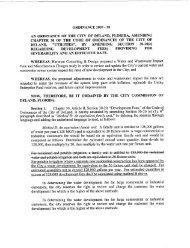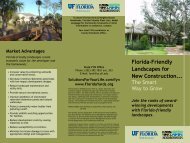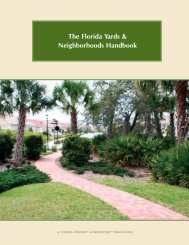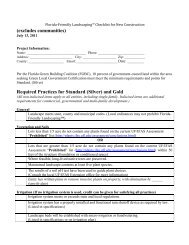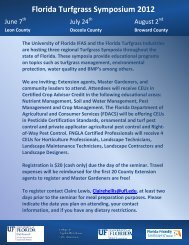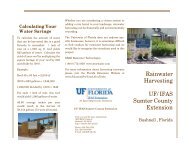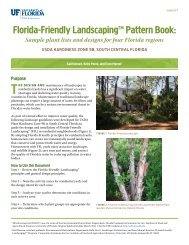A Guide to Florida-Friendly Landscaping A Guide to Florida-Fr ...
A Guide to Florida-Friendly Landscaping A Guide to Florida-Fr ...
A Guide to Florida-Friendly Landscaping A Guide to Florida-Fr ...
You also want an ePaper? Increase the reach of your titles
YUMPU automatically turns print PDFs into web optimized ePapers that Google loves.
Ardisia escallonioides<br />
Marlberry, Marbleberry<br />
CS<br />
9-11<br />
FL<br />
M-F<br />
10-21<br />
3-12<br />
<br />
S/L<br />
High<br />
H<br />
fragrant, white flowers all year; attractive foliage;<br />
round purple fruits widely used by wildlife, mostly in<br />
fall and winter; no pest problems; good for screens<br />
and hedges<br />
Arenga engleri<br />
Formosa Palm, Dwarf<br />
Sugar Palm<br />
CS<br />
9a-<br />
11<br />
NN<br />
Med.<br />
10<br />
16<br />
<br />
Any<br />
None<br />
L-N<br />
red/orange/green flowers in spring<br />
Baccharis halimifolia<br />
Groundsel Tree, Sea<br />
Myrtle, Salt-bush<br />
NCS<br />
8-10<br />
FL<br />
Med.<br />
8-12<br />
6-12<br />
<br />
Any<br />
Medium<br />
M<br />
white flowers in fall; poisonous seeds; useful for<br />
reclaiming wet sites, by retention ponds and drainage<br />
ditches<br />
Butia capitata<br />
Pindo Palm, Jelly Palm<br />
NCS<br />
8b-<br />
11<br />
NN<br />
Slow<br />
15-25<br />
15-25<br />
<br />
Any<br />
High<br />
M<br />
edible fruit used for jelly; attracts wildlife; looks best<br />
in full sun; white flowers; pest sensitive; high wind<br />
resistance<br />
Calliandra spp. and cvs.<br />
Powderpuff<br />
CS<br />
9b-<br />
11<br />
NN<br />
Fast<br />
10-15<br />
8-15<br />
<br />
Any<br />
High<br />
L-N<br />
pink/white flowers in spring-fall; invasive<br />
assessment: Calliandra haema<strong>to</strong>cephala assessed as<br />
not a problem, others not yet assessed<br />
Callistemon spp.<br />
Bottlebrush<br />
Camellia japonica<br />
Camellia<br />
Camellia sasanqua<br />
Sasanqua, Sasanqua<br />
Camellia<br />
NCS<br />
8b-<br />
11<br />
NC<br />
8-9<br />
NC<br />
8-9<br />
NN<br />
OK<br />
OK<br />
Med.<br />
6-30<br />
6-15<br />
Slow<br />
10-20<br />
10-20<br />
Slow<br />
3-15<br />
varies<br />
<br />
S/L<br />
<br />
Any<br />
<br />
Any<br />
High<br />
Medium<br />
Medium<br />
17<br />
M<br />
L-N<br />
L-N<br />
red flowers, spring-summer; medium–low wind<br />
resistance; attracts beneficial insects; invasive<br />
assessment: C. citrinus , C. rigidus, C. viminale<br />
assessed as not a problem, others not yet assessed<br />
many cultivars; flowers up <strong>to</strong> 6 inches, in winterspring,<br />
color variable; watch for scales, aphids,<br />
chewing insects and fungal diseases; requires acid<br />
soil and will have problems if pH is <strong>to</strong>o high<br />
some groundcover cultivars available; flowers in fallwinter,<br />
color variable; watch for scales, mites, aphids<br />
and chewing insects; requires acid soil and will have<br />
problems if pH is <strong>to</strong>o high



